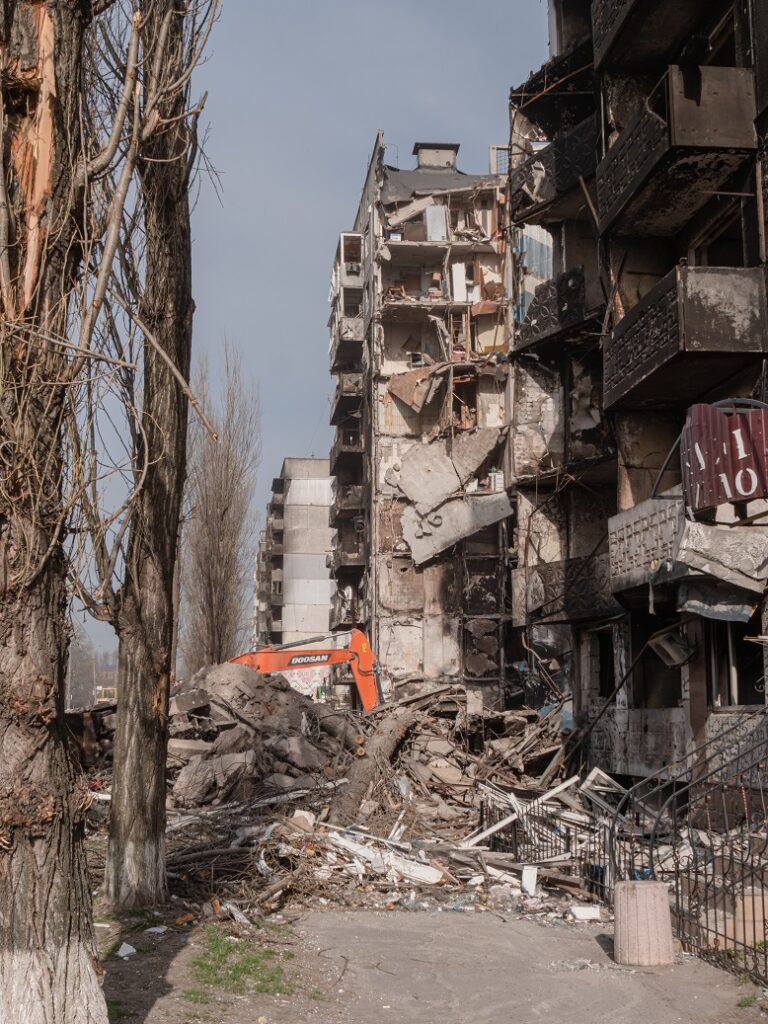Russia’s invasion has inflicted severe damage and losses on Ukraine, necessitating a massive rebuilding effort. Veronika Vakulenko argues that civil society must be involved in the recovery process and offers guidance to Nordic and Baltic policymakers on how to achieve this.
The full-scale invasion plunged Ukraine into an immediate crisis, resulting in widespread devastation and casualties. Military actions caused not only destruction and damage to residential buildings, educational and healthcare facilities, energy infrastructure, and historical heritage but also other types of economic, ecological, and demographic losses. The continued onslaught of war has triggered a long-term emergency. All Ukrainian regions are affected by damaged economic ties and demographic shifts that persist due to migration and ongoing mobilisation.
To respond to these challenges, a comprehensive and multi-level approach is needed to plan the reconstruction of Ukrainian society and economy. It is crucial to rebuild a stronger, safer, more disaster-resilient infrastructure and systems through environmentally friendly technologies in Ukrainian cities and increase the level of security for the return of people and the restoration of the country’s human potential.
As a social mega-project, the restoration process should be framed around three key aspects, i.e.,
- understanding regional diversities,
- using democratic mechanisms for recovery, and
- social accountability mechanisms enabling multiple stakeholder engagement.
Overview of damages and losses due to the war
During two and a half years of full-scale war, several reports were published on the devastation suffered by Ukraine due to the Russian aggression. World Bank experts presented one of the most comprehensive assessments in cooperation with the Ukrainian government, the European Union, and the United Nations. They distinguished between damages and losses, which should be acknowledged when assessing the situation in Ukraine and planning its further reconstruction.
| Damages are direct costs of destroyed or damaged infrastructure and physical assets. They are valued in monetary terms with costs estimated based on replacing or repairing these assets considering the replacement price prevailing before the war. Losses regard changes in economic flows resulting from the war; for example, monetary value of increased operating cost, loss of revenue for public and/or private sector, etc. |
As of December 31, 2023, the total amount of direct damages to residential, non-residential, real estate and other infrastructure amounted to more than $152 billion (World Bank et al., p. 35). The top three most affected regions are Donetsk, Kharkiv, and Luhansk. According to a report by the Kyiv School of Economics, the cumulative damages from the destruction of Ukrainian public sector facilities (social facilities and institutions, educational, scientific and healthcare facilities, cultural and sports facilities, administrative buildings, etc.) amount to approximately $15.6 billion. Damages of business assets amount to at least $11.4 billion, and the agricultural sector lost another $8.7 billion.
The estimate of overall losses is nearly $500 billion (World Bank et al., p. 35), and the industries most affected are business and commerce, agriculture, land resources, and energy. As an example, the explosion of Kakhovka Dam in June 2023 triggered losses of over $11 billion, and the direct damage to infrastructure and assets amounted to $2.79 billion (UN, 2023). As the war ravages on, both damages and losses continue to mount.

The recovery philosophy
Assessing damages and losses is a crucial starting point for planning the country’s continued reconstruction. Yet, as a dynamic baseline to be constantly monitored, the overview requires a thorough strategy from the government to collect and assess various needs.
“Build back better” refers to improvements that should be integrated into the restoration and reconstruction of damaged assets (World Bank et al., p. 28). These can, for example, include improved system functionality, enhanced resilience to emergency situations, systemic modernisation of critical infrastructure, and service provision to citizens.
Immediate action to reconstruct the country is needed, and Ukraine plans to implement immediate actions for national reconstruction through large-scale projects involving private actors and public-private partnerships. The Ukrainian government has identified key industries crucial for sustainable reconstruction, including the military sector, construction and infrastructure development, agriculture, energy, IT, and mechanical engineering.
Recovery is best approached as a collaborative, bottom-up process rather than a centralised, top-down action. Needs assessments and decision-making should actively involve local actors and, ideally, affected communities should be empowered with resources and responsibilities. By allocating state funding to local authorities, closer citizen-government interactions can be fostered, ensuring that the actual needs of those affected by destruction are effectively addressed. For reconstruction to be successful, authorities need to tailor-make large-scale projects and actively respond to local community feedback.
Importance of civil society in recovery and reconstruction
1. Mapping regional diversities
While it is evident that the whole of Ukraine suffered losses from the war, the character of those varies. Thus, it becomes crucial to map and evaluate regional needs in post-war reconstruction. While some Western regions experienced positive dynamics in budget revenues due to the relocation of businesses and increased inflow of residents (internally displaced people), the southeast of Ukraine suffered the most from the impact of military actions. Many cities will have to rise from the ashes, and this requires a holistic approach from both central and local authorities to restore life in affected territories.
Civil society organisations will be pivotal in regional mapping by providing local insights on acute problems. They can facilitate community consultations, gather localised information on damages and needs, and ensure that the diverse voices of affected populations are heard. By engaging local communities, civil society organisations help to identify specific regional priorities and contribute to a more accurate and comprehensive mapping of needs, which is essential for tailored and effective reconstruction actions.
2. Democratic mechanisms for recovery
After understanding the needs of each local community, mechanisms for engaging local citizens must be selected. Possible practices of citizen engagement in reconstruction could include:
- Piloting of projects. Launching pilot projects (i.e., creating green spaces, cultural and historical site restoration, renewable energy, and others) can allow communities to test small-scale reconstruction initiatives, thus serving as prototypes for more extensive efforts.
- Educational campaigns. This can include workshops conducted in collaboration with authorities on understanding planning documents, budgeting processes, and how to monitor project implementation.
- Participatory budgeting. While local Ukrainian governments have been experimenting with participatory budgeting since 2015, this practice stopped with the start of the war. It may be an ideal time to consider re-launching it to allow citizens to propose and vote on budget allocations for local projects, thereby increasing their involvement in decision-making processes, especially those focused on reconstruction.
- Communication channels between the government and citizens. Continuous, transparent and regular updates on the progress of reconstruction projects, budget expenditures, and upcoming public participation opportunities can build trust and encourage active citizen involvement.
While public hearings are the most common way to engage citizens, this approach is often criticised for limiting citizen participation to specific stages of the process. By incorporating a broader range of participatory mechanisms, Ukrainian authorities can ensure that citizens are involved from the initial idea generation through to the implementation and monitoring of reconstruction projects. This comprehensive engagement can help create a more responsive and effective recovery.
3. Social accountability and multiple stakeholder engagement
Reconstruction requires close interaction among numerous stakeholders: international donors, central and local authorities, state entities, private businesses, non-governmental organisations, and citizens. This process enacts collaborative governance, where trust and transparency become key elements in the recovery process. Thus, civil society participation serves as an important condition for ensuring accountability and control over the implementation of reconstruction projects and programs in Ukraine.
Currently, in Ukraine, several central government bodies and representatives of public organisations are collaborating to establish a transparent and effective reconstruction process. This has materialised in particular by a digital tool called Digital Restoration Ecosystem for Accountable Management (DREAM). This tool has been developed to follow the full cycle of restoration projects, from recording damage and identifying needs to creating a project map, public hearings, development of project documentation, procurement, construction, and audits.
Conclusions and policy advice for Nordic and Baltic governments
While the intention to apply democratic mechanisms in the development, implementation, and assessment of recovery initiatives in Ukraine is promising, the wide application of these mechanisms is still in its infancy. To facilitate public control of the multifaceted process of recovery, it is necessary to enhance capabilities and build competencies of both public authorities and citizens. Ukrainian institutions require maturation to enact complex social projects – such as post-war socio-economic reconstruction – built on democratic principles of freedom, equality, and transparency.
The Nordic and Baltic countries have extensive experience in fostering citizen engagement in democratic processes, offering valuable models for Ukraine. To help increase citizen participation in the country, these governments could support the following:
- Adoption of digital participation platforms. Inspired by Estonia’s e-governance model, Ukraine can develop and implement comprehensive digital platforms for citizen engagement. Estonia’s X-Road platform, which facilitates secure and efficient data exchange between various governmental and private sector entities, serves as a blueprint for creating a robust digital infrastructure to enhance transparency and citizen participation.
- Empowerment of local authorities. The Norwegian model of local governance, which emphasises decentralisation and the empowerment of local authorities, can be adapted to Ukraine’s needs. By sharing experiences with Norwegian municipalities (especially in the sphere of search and rescue operations), Ukrainian local governments can gain the necessary experience to ensure that reconstruction efforts are tailored to the specific needs of different regions, enhancing the effectiveness of recovery initiatives.
- Inclusive planning processes. The Nordic and Baltic approach to urban planning, which includes extensive public consultations and stakeholder engagement, can act as a model for Ukraine. Ukraine’s existing experience in involving citizens, businesses, and NGOs in emergency response can inform both the planning and implementation stages of reconstruction projects. For instance, Nordic and Baltic governments could form a working group to cooperate with Ukraine in fostering inclusive and gender-sensitive practices, ensuring that projects meet the diverse needs of the local population.
- Enhanced transparency and accountability. Nordic best practices in transparency and anti-corruption measures can guide Ukraine in establishing robust oversight mechanisms for reconstruction funds.


